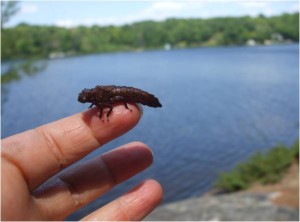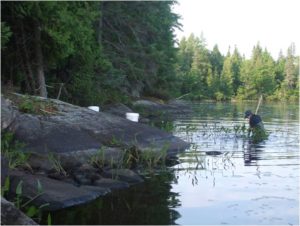It’s that time of year again – BUG TIME!
By Dylan Moesker
As the warm weather arrives; foliage begins to bloom, the birds start chirping and, of course, the bugs become fierce.

This dragonfly larvae is just one of the critters found in a health waterbody when sampling for benthos.
Muskoka has some of the most beautiful scenery and pristine lakes and rivers in the world and at the bottom of these lakes are bugs – also known as Benthic Macroinvertebrates (or benthos). Believe it or not, these bottom-dwelling critters, which consist of insect larvae, beetles, snails, clams, and worms, are actually amazing indicators of lake health. They provide useful information on our changing lakes because they are very sensitive to changes in water quality. Too many or not enough of a certain species can indicate negative impacts on that watershed.
Healthy watersheds provide a number of benefits such as fresh, clean drinking water, clean air, habitat for wildlife, recreational activities, and can drastically reduce the impact of natural disturbances. It is very important that we take pride in our water quality, and it takes the community to effectively monitor it due to the size and range of our watersheds. So, how can you get involved?
Since 2004, The District Municipality of Muskoka has worked with residents of Muskoka to sample and study benthos to monitor the water quality of our surrounding lakes. Many lake associations are proud to have been involved with the study for many years, which allows them to annually monitor their lake and gain a better understanding of it.
The only thing is we want more participants! This program revolves around you- community members who care about your lake. By joining this monitoring program, you too can help with the goal of protecting our water quality. Now, you are wondering how it all works right?

The Biological Monitoring Technician collects the sample and volunteers help analyze it through the District of Muskoka’s Benthic Monitoring Program.
The Biomonitoring Technician will take samples from your lake which are then identified and sorted with the help of dedicated volunteers provided by you. The process usually takes the entire day, but can be shorter with the right number of volunteers.
The data are then submitted to the Ontario Benthos Biomonitoring Network database and results are sent back to lake associations members. Technical assistance and all supplies are provided by the District of Muskoka for volunteer groups who participate in the program and volunteer hours can be provided to interested high school students.
If you’d like to participate in the Biological Monitoring Program to help monitor the health of your lake, please contact the District of Muskoka’s 2013 Biomonitoring Technician, Dylan Moesker, at [email protected] or call 705-645-2100 ext. 332.
Past articles are available in this blog under the Watershed Notes Articles category or under Past Articles in the Resources section.
